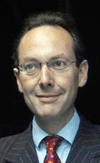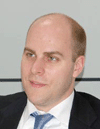Archive » 2005 » Issue 36 (December/January)
Futuristic models to get message across
01 December, 2005
How is it possible to give adequate client support and information in the ever increasing open architecture arena? Sophistication is the key
|
Water products flow into investors’ consciousness
01 December, 2005
The Zurich-headquartered private banking arm of Credit Suisse has made a significant tranche of its profits in recent years from the sale of structured products. Delegates at PWM’s third Open Architecture Forum questioned whether these products were genuinely pulled off the bank’s shelves by needy clients, or pushed by greedy advisers.
|
New alternatives landscape leaves much room for debate
01 December, 2005
PWM invites all distributors and manufacturers active in the German investment market to an afternoon seminar to be held in Frankfurt on 22 February.
|
Global scope spurs on strong AUM gains
01 December, 2005
The world’s top wealth managers continued to see strong growth in their assets under management (AUM) during the first half of 2005. An examination of the 25 biggest wealth management firms shows that assets for this group increased by an average of 7.29 per cent in base currency terms. This is nearly equal to the 7.59 per cent average full-year performance for the 58 organisations that we at the Scorpio Partnership covered in our 2004 year-end Private Banking Benchmark.
|

|
Harding: new ideas are not solutions |
Industry attacked for client neglect
01 December, 2005
Financial services practitioners are increasingly breaking ranks and criticising their own industry for its lackadaisical attitude when it comes to giving the best deal to consumers. While this critical introspection has definitely not been embraced by huge private banking powerhouses such as Credit Suisse, UBS and Deutsche Bank, it was clearly gaining acceptance among speakers at PWM’s third Open Architecture Forum.
|
Principal opens doors to niche bond market
01 December, 2005
US-based fixed income house Principal Global Investors has nearly doubled funds under management in the last three years and is now mounting a challenge to bigger competitors by attempting to amass third-party assets in Europe through its niche preferred securities products, writes Elisa Trovato
|
PGI’s fast track to increasing international assets
01 December, 2005
Assets under management at Principal Global Investors have grown from $80bn to $155bn over the last three years. “That makes us, over that period, one of the fastest growing active managers in the US market,”
|

|
‘I do not think the customer should be expected to grasp complex financial issues. But we have an accountability to deliver products, information and advice in a manner which is intelligible and digestible by financial consumers’
James Bevan, chief investment officer,
Abbey |
Guiding clients to the right choice
01 December, 2005
With open architecture releasing a plethora of choice for the average investor, it is perhaps more prudent for banks to guide consumers towards the correct asset allocation and product structure, rather than obsessively choosing individual funds. Elizabeth Cripps looks at the options
|
Open architecture as part of wider picture
01 December, 2005
For many individuals with assets to invest, their existing savings bank will be the first port of call. In this way, banks often have an opportunity to offer fund selection and asset allocation as part of a wider range of banking services.
|
Hedge funds strategies for traditional investors
01 December, 2005
Mathieu Vaissié presents a pragmatic solution for investors to build their core hedge fund portfolio and then shows how they can implement a style rotation to design a satellite hedge fund portfolio. This core/satellite approach to alternatives can reduce risk exposure as well as increasing returns
|
New found freedom with total returns
01 December, 2005
The flexibility of strategic and tactical asset allocation coupled with a total return philosophy makes it an ideal buffer to today’s unpredictable market. John Foster looks into the types of assets on offer and how to deploy them
|
A new breed of solutions embraces credit instruments
01 December, 2005
Ope Agbaje outlines some of the innovative credit-based solutions available as alternatives to traditional sovereign and credit fixed income strategies to fill the satellite space
|
Add active ingredients to spice up passive portfolios
01 December, 2005
Nelson Wicas looks at the importance of asset allocation, the case for indexing and the role for active funds in core-satellite portfolios
|
Offshoring: a home away from home
01 December, 2005
Offshoring certain office functions may be a cost saving device, but it is essential that the firm works with the outsourced employees in partnership as well as choosing the right geographical location, writes Elizabeth Cripps
|
Optimism high despite bad spell
01 December, 2005
A bad October and Avian bird flu fears may have dented equity returns but investors are still bouyant about continued growth in the new year, writes Simon Hildrey
|

|
Felgenhauer: Kremlin funds safer bet |
Unflagging faith in Russia stock growth
01 December, 2005
Moscow-based Hermitage Capital Management maintains that the Russian stock market is one of the cheapest in the world with valuations accompanied by higher earnings growth, writes Elisa Trovato
|
Bernard Aybran
01 December, 2005
“Our balanced portfolio keeps its bias toward equities. Markets have lost some ground in October, which has been seized initiating some holdings, in particular, a diversification away from Europe towards the US and Japan. However, the ongoing period of rate increases around the world prevents us from being too aggressive on the equity weighting of the portfolio: inflation fears may prove being a serious headwind for most markets, with the exception of Japan, where it would be seen as a return to a more healthy economy. The US holdings have been increased because of the lag.”
|
Robert Burdett
01 December, 2005
“October finally saw the bull run pause, with sharp falls in most markets in euro terms. Our Japanese selection bucked the trend with its domestic small cap focus benefiting from improving Japanese economic data. We are of the belief that the bullish camp will be right but not without some moments of nervousness. Consequently, we choose to remain fully invested. One asset allocation change this month is to increase emerging markets out of bonds.”
|
David Bulteel
01 December, 2005
“US interest rates were increased for the 12th time since June 2004. Equity markets ran into profit taking during October, as earlier gains were perceived to have taken too rosy a view of the economic outlook. However, they have recovered as valuation levels appear supportive, backed by the outbreak of bid activity. Patience may be required, rather than an unduly defensive investment stance, to allow the market to reflect upon the inflation risks and form a clearer impression of prospects for growth in 2006.”
|
Michael Richter
01 December, 2005
“Our last scale back in equities paid off as stock markets declined sharply in October. As we see as equities much more attractive than bonds, we sold the American Express Global High Yield Euro fund and increased the broadly diversified Magna Global Emerging Markets Equity fund. We switched the Henderson HF Global Property fund into Henderson HF Asian Property fund, which will reap the benefits of the real-estate prices in Asia. We also raised our Japan exposure through the M&G; Global Leaders fund.”
|
Pierre Bonart
01 December, 2005
“No major changes since our last review. Our main strategic allocation theme remains the attractiveness of equity markets against other traditional asset classes, especially fixed income. We therefore maintain our low exposure to fixed income, which has benefited from the rise of interest rates both in the US and in the Euro zone. We also continue to recommend investments in alternative assets and are therefore invested in a multi-strategy fund of hedge funds, which potentially give the same long-term returns for a much lower volatility.”
|
Marjolijn Breeuwer
01 December, 2005
Our equity exposure to US managers continues to shrink while Europe, UK, Asia and emerging markets have justified an increase in allocations. We have been looking to further diversify our Asia ex-Japan holdings and therefore added First State Asia Pacific Leaders, run by Angus Tulloch and the First State Asian team. The fund is similar to the successful First State Asia Pacific, which is practically closed to new investors. All team members have been involved in the Asia Pacific markets for substantial. The addition of this team will add value and provide further diversification in the coming period.”
|
Panel Investment
01 December, 2005
Each month in PWM, six top European asset allocators reveal how they would spend E100,000 in a fund supermarket for a fairly conservative client with a balanced strategy.
|